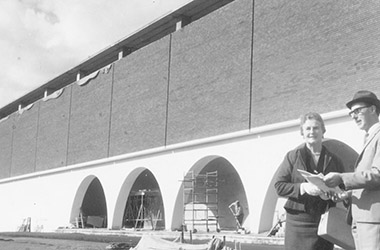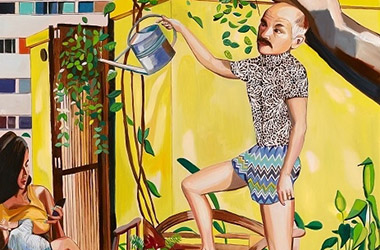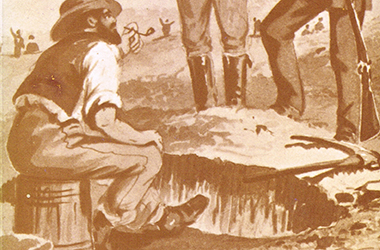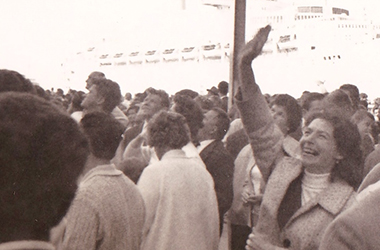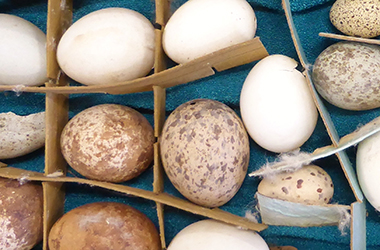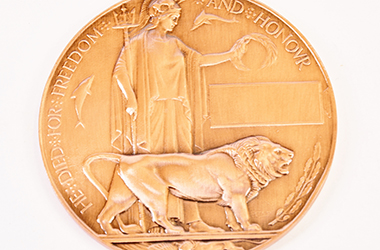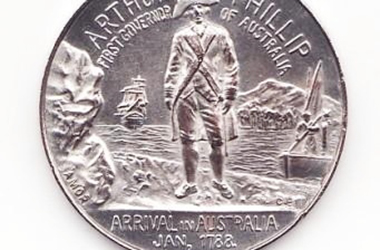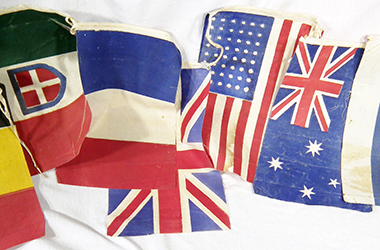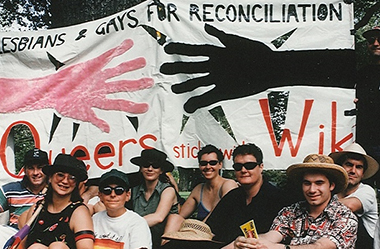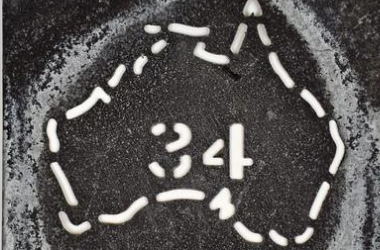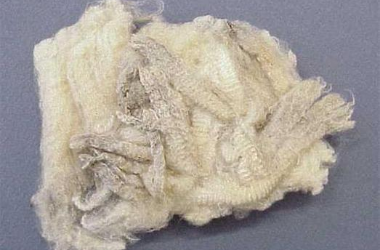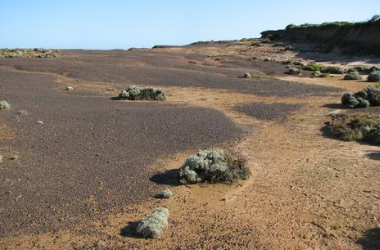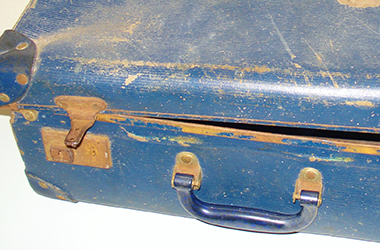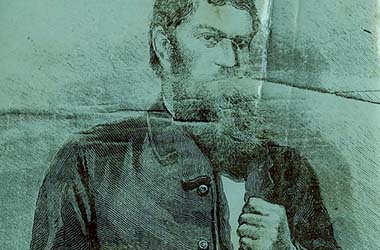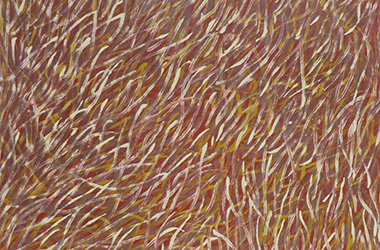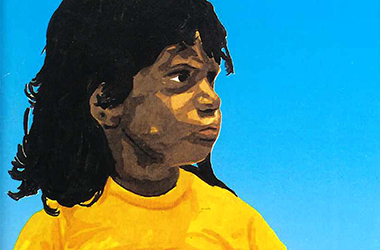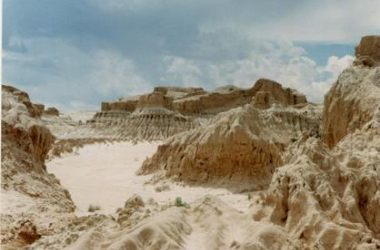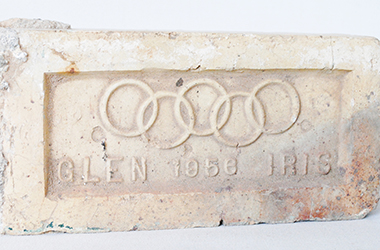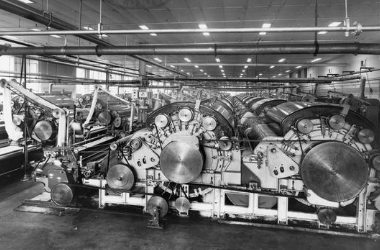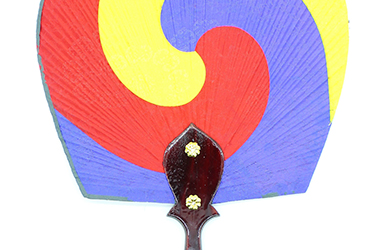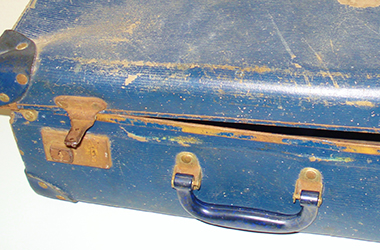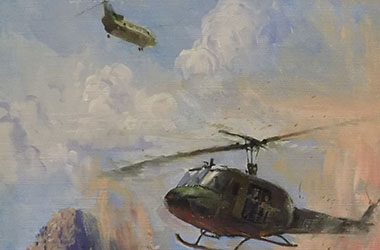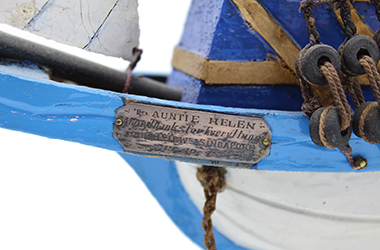Browse stories
-
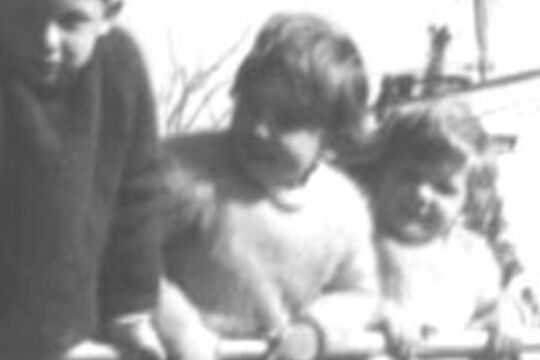
Digital Stories of the Mind and Body
Stories of the mind and body are a tribute to the resilience of the human mind and spirit in dealing with the challenges of the body.
The Australia Centre for the Moving Image (ACMI) has developed its digital storytelling program in partnership with many health and community advocacy organisations to serve people with special needs or life issues.
Participants associated with these organisations have taken part in the ACMI digital storytelling workshop to tell their unique stories of courage and survival. These personal narratives have provided an opportunity for the participants to use their creativity and voice as a centrepiece for health promotion and social justice efforts.
-

A Sensory Experience
The mainstream understanding of deaf and blind people has shifted over time. When once it was thought that blind people should be taken care of and sheltered, or deaf people taught to hear and speak, a deeper awareness of distinct culture and experience has emerged.
'A Sensory Experience' explores the world through the eyes and ears of the deaf and blind communities in Victoria and seeks to demystify some of the stereotypes and preconceptions that survive to this day.
The four films that make up part of this story highlight Victoria’s Deaf and blind communities within an historical framework, fostering new insights and provoking thought about the way we understand these communities today. Each film is an open invitation to share the experience of the world from another perspective.
The accompanying images complement the films, giving further understanding to the rich history held within the two groups. In addition, two contemporary essays by prominent writers offer the unique opportunity to share their lived experiences. Finally, the story contains an education kit for secondary students, which allows for a deeper study and understanding.
-

Women's Suffrage
2008 marked the centenary of the right for Victorian non-indigenous women to vote.
During 2008 the achievements of the tenacious indigenous and non-indigenous women who forged a path through history were celebrated through an array of commemorative activities.
How the right to vote was won…
In 1891 Victorian women took to the streets, knocking door to door, in cities, towns and across the countryside in the fight for the vote.
They gathered 30,000 signatures on a petition, which was made of pages glued to sewn swathes of calico. The completed petition measured 260m long, and came to be known as the Monster Petition. The Monster Petition is a remarkable document currently housed at the Public Records Office of Victoria.
The Monster Petition was met with continuing opposition from Parliament, which rejected a total of 19 bills from 1889. Victoria had to wait another 17 years until 1908 when the Adult Suffrage Bill was passed which allowed non-indigenous Victorian women to vote.
Universal suffrage for Indigenous men and women in Australia was achieved 57 years later, in 1965.
This story gives an overview of the Women’s Suffrage movement in Victoria including key participants Vida Goldstein and Miles Franklin, and the 1891 Monster Petition. It documents commemorative activities such as the creation of the Great Petition Sculpture by artists Susan Hewitt and Penelope Lee, work by artists Bindi Cole, Louise Bufardeci, and Fern Smith, and community activities involving Kavisha Mazzella, the Dallas Neighbourhood House, the Victorian Women Vote 1908 – 2008 banner project, and much more…
Further information can be found at the State Library of Victoria's Ergo site Women's Rights
Learn more about the petition and search for your family members on the Original Monster Petition site at the Parliament of Victoria.
Educational Resources can be found on the State Library of Victoria's 'Suffragettes in the Media' site.
-

History in Place
The History in Place project connects teachers and students with their local history via a community collecting society or museum.
History in Place provides an innovative and practical implementation of the new Australian Curriculum in History and Victoria's Framework of Historical Themes. It provides a framework for students to engage with their local history and heritage in a fun and challenging way using digital technologies. The program has been designed for grades 5 and 6, but has also been used for year 9s.
History in Place can be initiated either by schools or by community museums and heritage organisations. Students use collection items and interviews with local experts to create short films using tablet devices.
This story includes examples of what happens during a day of History in Place, examples of student films from the program pilot and an education toolkit (available from the Education Resources tab below) which includes course materials, instructional materials and everything that a museum and school need to implement the program.
The pilot program partnered 6 primary schools from across Victoria with local museums.
Museums participating in the pilot were: Barwon Park, Burke Museum, CO.AS.IT Museum, Golden Dragon Museum, the Mildura Arts Centre and Yarra Ranges Museum.
The project is a partnership between the Heritage Council of Victoria, the History Teachers' Association of Victoria and Culture Victoria. The pilot was funded by the Telematics Trust.
During the History in Place pilot, students used the Linking History site to research their films. Linking History is an experimental pilot in the practical application of linked open data, and is part of Portrait of a Nation: History In Place Access Project which is a Centenary of Canberra project, proudly supported by the ACT Government and the Australian Government.
-

Melbourne Trams: Step aboard!
'Introduction to Melbourne Trams: Step aboard!'
Written by Carla Pascoe, May 2012
Trams are what make Melbourne distinctive as a city. For interstate and overseas visitors, one of the experiences considered compulsory is to ride a tram. When Melbourne is presented to the rest of the world, the tram is often the icon used. The flying tram was one of the most unforgettable moments of the Opening Ceremony of the 2006 Commonwealth Games. When Queen Elizabeth II visited Australia in 2011, she was trundled with regal dignity along St Kilda Road in her very own ‘royal tram’.
The history of trams is closely bound up with the history of this southerly metropolis. Melbourne’s tram system originated during the 1880s economic boom when the Melbourne Tramway and Omnibus Company opened the first cable line. Cable tram routes soon criss-crossed much of the growing city and cable engine houses can still be seen in some inner suburbs, such as the grand building on the south-east corner of Gertrude and Nicholson streets, Fitzroy. Some older passengers like Daphne Rooms still remember riding cable cars.
In the late 19th century, cable and electric tram technologies were vying for supremacy. Australia’s first electric tram line opened in 1889, running through what was then farmland from Box Hill station to Doncaster. The only surviving clue that a tram line once traversed this eastern suburb is the eponymous Tram Road, which follows the former tram route in Doncaster.
Gradually, various local councils joined together to create municipal Tramways Trusts, constructing electric lines that extended the reach of the cable system. In 1920 the tram system came under centralised control when the Melbourne and Metropolitan Tramways Board (MMTB) consolidated the routes and began electrifying all cable lines.
Manpower shortages during World War II meant that Australian women stepped into many roles previously reserved for men. The tramways were no exception, with women being recruited as tram conductors for the first time. After the war, tram systems were slowly shut down in cities around both Australia and the world, as transport policies favoured the motor vehicle. But thanks to the stubborn resistance of MMTB Chairman, Sir Robert Risson, as well as the wide, flat streets that characterise the city’s geography, Melbourne retained its trams.
Melbourne’s tram industry has always possessed a unique workplace culture, characterised by fierce camaraderie and pride in the role of the ‘trammie’ (the nickname for a tram worker). Many Trammies, like Bruce MacKenzie, recall that they joined the tramways because a government job was seen as a job for life. But the reason they often remain for decades in the job is because of the strong bonds within the trammie ‘family’. This is partly due to the many social events and sporting clubs that have been attended by Trammies, as Bruce MacKenzie remembers. It is also because the demands of shift work bond people together, explains Roberto D’Andrea.
The tram industry once employed mainly working-class, Anglo-Australian men. After World War II, many returned servicemen joined the ranks, bringing a military-style discipline with them. With waves of post-war migration the industry became more ethnically diverse, as Lou Di Gregorio recalls. Initially receiving Italian and Greek workers from the 1950s and 1960s, from the 1970s the tramways welcomed an even broader range of Trammies, from Vietnamese, South American, Turkish and other backgrounds.
Trammies perform a wide range of tasks critical to keeping the system running, including driving, track maintenance, tram maintenance, time tabling, customer service and more. But just as designs of ‘rolling stock’ have changed - from the beloved veteran W class trams to the modern trams with their low floors, climate control and greater capacity - so too have the jobs of Trammies changed over time. Bruce MacKenzie remembers joining the Preston Workshops in the 1950s when all of Melbourne’s fleet was constructed by hand in this giant tram factory. Roberto D’Andrea fondly recalls the way that flamboyant conductors of the 1980s and 1990s would perform to a tram-load of passengers and get them talking together. As a passenger, Daphne Rooms remembers gratefully the helping role that the connies would play by offering a steadying arm or a piece of travel advice.
Trams have moved Melburnians around their metropolis for decades. As Daphne maintains, ‘If you can’t get there by tram, it’s not worth going’. Everyone has memories of their experiences travelling on trams: some funny, some heart-warming and some frustrating. Tram driver, Lenny Bates, tells the poignant story of the blind boy who would sometimes board his tram on Collins Street and unhesitatingly call out the names of the streets they passed. As the films in this collection demonstrate, every passenger has their routes that they customarily ride and these routes take on a personal meaning to their regulars. You could say that every tram line has its own distinct personality. Whilst the way the tram system is run inevitably changes across time, one thing has been constant: trams have always played a central role in the theatre of everyday life in Melbourne.
-

Melbourne and Smellbourne
Over the last 150 years Victoria has experienced a number of landmark capital works and landscaping projects in response to its changing economic, environmental and cultural relationship to water. The sewerage system that we take for granted today had to be built from scratch.
For all the grandeur that was 'Marvellous Melbourne' in the 1880s, the city was nicknamed 'Smellbourne', and for good reason. The building of Yan Yean Reservoir in the 1850s had ensured the availability of fresh water, but there was still no sewerage system.
An appalling stench wafted from the many cesspits and open drains. 'Nightsoil' (as human waste was politely referred to) polluted the streets and ran into the Yarra. Nightsoil collectors frequently dumped their loads on public roads. Ignorance and neglect of the hygienic disposal of human waste had devastating results at this time when hundreds died in a savage outbreak of typhoid.
Melbourne and Metropolitan Board of Works
In 1891 the Melbourne and Metropolitan Board of Works (MMBW) was created. It immediately began plans to build an underground drainage system linked to a pumping station at Spotswood, located on the western banks of the mouth of the Yarra River. The sewage flowed by gravity to Spotswood, where it was then pumped to the Werribee Treatment Farm.
Spotswood Pumping Station
Spotswood Pumping Station built to pump Melbourne's sewage to Werribee, was finished in 1897. At the pumping station, steam engines (later replaced by electrical ones) worked to pump the sewage up a rising main to join the major sewer outfall at the head of the pumping mains near Millers Road at Brooklyn. The outfall sewer then carried the sewage to the Werribee Treatment Farm where it was purified and discharged into the sea.
Werribee Farm
Werribee was the perfect site for the MMBW's new sewage farm. The farm was the Board's most important project, and one of the largest public works undertaken in Australia in the nineteenth century.
Land at Werribee was cheaper than at Mordialloc - the other site considered. Rainfall was low compared with the rest of Melbourne, which meant the land would adapt well to irrigation. Werribee was also 9 miles (14.4 KM) away from the nearest boundary of the metropolitan district (Williamstown), and 24 miles (38.6 KM) away from the influential and well-to-do suburb of Brighton. The Chirnside family sold 8,857 acres (3.2 hectares) to the Board for 17 pounds per acre.
The Earl of Hopetoun, Governor of Victoria, turned the first sod of earth in a ceremony on May 1892, which marked the beginning of the building of the outfall sewer near Werribee.
Connection!
On 5 February 1898, a ceremony marked the official connection of Melbourne to the new sewerage system. Guests - politicians, board members, city councillors and federal delegates - boarded a steamer to watch the Governor, Lord Brassey, raise the penstock (the partition between the smaller and larger sewers) at the Australian Wharf. They then visited the pumping station at Spotswood and the sewage farm at Werribee. Horses and carts conveyed the 180 guests around the farm.
After lunch and toasts, many of which looked forward to the future of a federated Australia, MMBW Chairman Mr Fitzgibbon proudly declared it "was not a question of how much the scheme was going to cost, but how much it was going to save in the lives of the citizens." Before the work was completed he hoped to see those puny punsters and petty wits who spoke of Melbourne as Marvellous Smellbourne constrained to speak of her as one of the sweetest and healthiest cities of the world.
-

Seeing the Land from an Aboriginal Canoe
This project explores the significant contribution Aboriginal people made in colonial times by guiding people and stock across the river systems of Victoria.
Before European colonisation Aboriginal people managed the place we now know as Victoria for millennia. Waterways were a big part of that management. Rivers and waterholes were part of the spiritual landscape, they were valuable sources of food and resources, and rivers were a useful way to travel. Skills such as swimming, fishing, canoe building and navigation were an important aspect of Aboriginal Victorian life.
European explorers and colonists arrived in Victoria from the 1830s onwards. The newcomers dispossessed the Aboriginal people of their land, moving swiftly to the best sites which tended to be close to water resources. At times it was a violent dispossession. There was resistance. There were massacres. People were forcibly moved from their traditional lands. This is well known. What is less well known is the ways Aboriginal people helped the newcomers understand and survive in their new environment. And Victoria’s river system was a significant part of that new environment.
To understand this world we need to cast ourselves back into the 19th century to a time before bridges and cars, where rivers were central to transport and movement of goods and people. All people who lived in this landscape needed water, but water was also dangerous. Rivers flooded. You could drown in them. And in that early period many Europeans did not know how to swim. So there was a real dilemma for the newcomers settling in Victoria – how to safely cross the rivers and use the rivers to transport stock and goods.
The newcomers benefited greatly from Aboriginal navigational skills and the Aboriginal bark canoe.
CULTURAL WARNING: Aboriginal and Torres Strait Islander users are warned that this material may contain images of deceased persons and images of places that could cause sorrow.
-

Digital Stories of Young Adults
Being a teenage mother, expressing the power of music and defining identity and sexuality are just some of the stories shared by the young people who have taken part in the Australian Centre for the Moving Image (ACMI) Digital Storytelling program.
Inside each story is a profusion of ideas and emotions that are edited together as an illuminating way for the young storytellers to evoke memories, places and events that inspire them. Digital Storytelling provides a powerful multimodal learning tool that allows young people to tap into their creativity and critical awareness while allowing for a fluid manipulation and construction of technical and storytelling knowledge.
For more information visit the Australian Centre for the Moving Image website
-

Early Photographs - Gold
These images are part of the first photographic series of Australian scenes presented for sale to the public. Produced by the studio of Antoine Fauchery and Richard Daintree in 1858, these photograph are from a series of 53 collectively known as the Fauchery-Daintree Album.
Using the latest collodion wet-plate process, Fauchery and Daintree produced their collection of albumen silver prints at a time when the sales of photographs were flourishing.
Antoine Fauchery and Richard Daintree produced iconic images of both early gold diggers and the landscapes scarred by the exploding search for gold, which attracted miners from all over the world and created the boom that made Melbourne the fastest growing metropolis of the time.
Antoine Fauchery and Richard Daintree were both migrants who tried their luck on the goldfields – Daintree coming out from England in 1853, Fauchery from France in 1852.
Unsuccessful on the goldfields, in 1857 they combined forces to produce a series of photographs titled Sun Pictures of Victoria, capturing important early images of the goldfields, Melbourne Streets, landscapes and portraits of Indigenous Victorians. Using the new collodion wet-plate process, they created albumen silver prints of a rare quality for the time.
Further information on Antoine Fauchery's time in Melbourne can be found at the State Library of Victoria's Ergo site.
-

Eureka Stories
What is Eureka and what happened there?
In the early hours of 3 December 1854 a force of police and other troops charged a reinforced camp constructed by miners on the Eureka gold diggings. About 150 diggers were inside the stockade at the time of the attack. In the fighting, 4 soldiers and about 30 other people were killed, and another 120 people taken prisoner. Thirteen people from the stockade were charged with treason – these men were either tried and found not guilty, or charges against them were dropped.
Many people think of the Eureka Stockade as a battle between the diggers (rebellious Irish fighting for democracy) and the police and colonial militia (the forces of the British Crown in the Colony). It’s nice to have a single story to make sense of everything. Eureka, however, is not a single simple narrative. Several stories intertwine and involve many of the same people and places. Let’s look at some of them.
The Hated Gold Licences
In 1854, people mining for gold around Victoria had to pay a monthly fee of 30 shillings for the right to mine, regardless of how much gold they found. Someone who had been looking for gold unsuccessfully for months still had to pay the same fee as someone who was pulling out gold by the pound. Diggers argued that it was an unfair tax, imposed on them without their consent, as they did not have the right to vote. (After the Goldfields Royal Commission the licensing fee was changed to a tax on gold when it was being exported.)
Not only did the diggers resent the licence fee, they were angry at the way the goldfields police went about checking that miners had licences. Diggers claimed that police were beating people up or chaining them to trees if they could not produce a licence, and undertaking unnecessary inspections on people they didn’t like. Resentment of the licence fee and the conduct of police in their “licence hunts” was expressed across the Victorian goldfields.
The Unfair Treatment of Diggers by the Police and Justice System
People around the Victorian goldfields were also unhappy with the lack of thoroughness with which police had investigated a number of goldfields crimes. They were concerned about what they thought was the unfair and secretive way people were charged and convicted of crimes. There were claims by people living on the goldfields that it was necessary to bribe police and government officials in order to do business and stay safe. As the goldfields populations increased, tensions between the goldfields communities and police and other government officials rose.
In Ballarat a series of events (a murder, an arrest and a hotel burning) in late 1854 involving police and Ballarat locals led to the arrests of three men for burning down the Eureka Hotel. These arrests caused enormous disquiet in the area, adding weight to calls by the Ballarat Reform League and other organisations around the goldfields for a fundamental change to the system of government in the Colony – the next element in our Eureka story.
Demands for a Democratic Political System
Since the early 1850s people had been calling for the government to abandon the gold licensing system, remove the gold commissioners, and provide the Colony with a better policing and justice system. Despite an investigation by the Victorian parliament into the goldfields in 1853 (a Legislative Council Select Committee) the government did not make significant changes. By November 1854 an organisation called the Ballarat Reform League had formed in response to official inaction and had written a Charter of democratic rights. They organised a "monster meeting" in Ballarat on 11 November 1854, to have it accepted, and met with Governor Hotham on 27 November 1854, to demand his acceptance of the Charter, and the release of the three prisoners charged with burning down the Eureka Hotel.
Population Explosion
The people calling for these changes to taxes, justice and political participation came from many different parts of the world, such as the United States, Canada, England, Ireland, Scotland, Italy, Germany. This corner of South-Eastern Australia was rapidly changing as thousands and thousands of people arrived to search for gold. Many of these people were educated and from middle-class or merchant backgrounds. The domination of squatters running sheep on large land holdings was being challenged by dense populations of people in goldrush regions generating enormous wealth in the colony, and a desire from these recent arrivals to take up land, and have a say in the making of laws.
We have looked at some parts of the Eureka story; at what unfolded around the colony as a result of this mix of people, events and system of government. There are many other stories about Eureka. To find out more, you can explore the stories through original documents at Eureka on Trial.
-

Family Stories
From the nuclear to the extended family, from groups of close friends, communities and neighbourhoods, to one on one relationships: family means many different things to different people.
Family describes our most cherished, and sometimes most difficult, relationships. In this collection of digital stories and videos, Victorians share their family stories.
Family stories include stories of immigration; disadvantage and survival, indigenous life, stories of sickness and health; life and death; childhood and old age.
CULTURAL WARNING: Aboriginal and Torres Strait Islander users are warned that some of the videos in this story may contain images of deceased persons and images of places that could cause sorrow.
-

Felon Families
Stories of Women Prisoners and their Families
"Life in the colony of Victoria during the 19th century could be fraught with difficulties for families and, particularly, for women. The problems they encountered in hard times were exacerbated by distance from the support and friendship of their extended families. If women found themselves unable to cope, the repercussions for the whole family could be tragic.
The stories and images of women who passed through Victoria’s penal system in the 19th century include: Elizabeth Scott, a young girl forced into marriage, living in an isolated part of the country, and the first woman hanged in Victoria; the baby farmer Frances Knorr; Martha Needle who's story is unusual because her crimes arose not out of the severe circumstances of colonial Victoria but from universal, age-old family and personal dysfunction; Emma Williams a single mother who drowned her baby son and brought the Champion newspaper to claim in October 1895 that her case would "exhibit Victoria to the world as the very lowest and most degraded of all civilised communities"; and Janet Dibden who wrote poetry while imprisoned at the Old Melbourne Gaol. It also includes Ellen Kelly the mother of bushranger Ned Kelly, who told her son "Die brave, die like a Kelly" before he was hanged."
The text above has been abstracted from an essay Felon families: Stories of women prisoners and their families written by Diane Gardiner for the publication The Australian Family: Images and Essays. The full text of the essay is available as part of this story.
This story is part of The Australian Family project, which involved 20 Victorian museums and galleries. The full series of essays and images are available in The Australian Family: Images and Essays published by Scribe Publications, Melbourne 1998, edited by Anna Epstein. The book comprises specially commissioned and carefully researched essays with accompanying artworks and illustrations from each participating institution.
-

Goldfields Stories: Dai gum san, big gold mountain
It may come as a surprise to some that the oldest Imperial Dragon in the world, Loong, is to be found in Bendigo, Victoria.
In 1851 gold was found in the Bendigo region. News reached China and by 1853 Chinese miners started to arrive at Dai Gum San (Big Gold Mountain). By 1855 there were up to 4000 Chinese in the Bendigo goldfields, about one fifth of the population.
By the 1860s, Bendigo was becoming a wealthy and established town, and in 1869 The Bendigo Easter Fair and Procession was initiated to raise funds for the Bendigo Benevolent Asylum and Hospital. By 1871, the Chinese, keen to support the wider community, joined the procession, providing music, theatre and acrobatic displays. Their position as the main attraction at the Fair was confirmed by 1879.
All of the costumes, flags and musical instruments were imported from China, with no expense spared. For the 1882 Fair, 100 cases of processional regalia were imported. In 1892 a further 200 cases arrived, along with Loong, the Imperial five-clawed dragon, who made his first appearance that year.
The traditions established in the 1860s by the Bendigo Chinese community continue to this day. As well as providing the main attraction in the Bendigo Easter Festival, ceremonies such as the Awakening of the Dragon are conducted. These traditions reflect uniquely preserved traditions, many of which were lost or discontinued in mainland China. They also reflect traditions, such as the main celebration taking place at Easter rather than Chinese New Year, that trace the history of the Chinese in Victoria.
The remarkable collection of 19th Century processional regalia that has been preserved by the Chinese community in Bendigo is held in the Golden Dragon Museum. It is not only a collection of world significance but, importantly, it contextualises and preserves the living heritage of both Victoria and China.
-

Goldfields Stories: The cycling wedding photographer
Wal Richards loved weddings. Given a box brownie camera as a young man in 1946, he started cycling on his blue and white bike to weddings in Maryborough and surrounding towns. Uninvited, he would position himself up close to the action and record events in his candid and unorthodox style.
Wal’s physical and mental disabilities meant that he was an easy person to underestimate and many people assumed that he didn’t have film in his camera. But in 1996, when Wal passed away, his family found more than 20,000 unsorted wedding photographs stored in shoe boxes in his house.
The collection was donated to the Maryborough-Midlands Historical Society. In 1998 the Central Goldfields Regional Art Gallery held an exhibition of Wal’s work. His striking photos and remarkable story generated broad interest and was written up in Time Magazine.
Whilst only a small portion of the weddings in Wal’s photographs have been identified so far, the collection is a remarkable and unusual social history of Maryborough spanning almost half a century.
The collection is housed at the Maryborough-Midlands Historical Society, which is located in the Worsley Cottage Complex.
-

Images of Melbourne
Explore Melbourne through selected works from the National Gallery of Victoria.
These artworks capture phases of the city's development, and offer a portrait of the people, places and streetscapes that define it.
-

James Harrison: Journalist, Inventor and Visionary
Although largely unacknowledged today, James Harrison was a major figure in the history of the city of Geelong. A politician, engineer, inventor, publisher and journalist, he was a man of huge energy and diverse talents.
In the 1850s he invented the worlds first ice-making machine from experimentations begun along the Barwon River in Geelong. He was also the founding editor of the Geelong Advertiser, after purchasing an old press from John Pascoe Fawkner and he was an important public commentator in the colony. He was a member of Geelong's first town council and represented Geelong in the colony of Victoria's Legislative Assembly.
Although travelling to Britain, and producing the first large commercial ice making machines, his business enterprises were not a success. He pioneered the development of a precursor to the modern refrigerated transport container but it failed during an experimental shipment of refrigerated beef to England and he was financially ruined.
After his death at Point Henry, Geelong in 1893 the people of Geelong paid for his tombstone and it was inscribed with the biblical quotation "one soweth, one reapeth".
-

Moomba
Moomba is one of Australia's most enduring festivals, first held in 1955.
It is held every Labour Day weekend and can feature a float parade, stalls, fireworks and water sports on the Yarra. One of the more idiosyncratic events is the Birdman Rally, where competitors jump off a 4m platform into the Yarra, wearing homemade "wings".
Popular rumour holds that Moomba's naming was the result of a subtle Aboriginal joke, and that while organisers believed Moomba to signify, "let's get together and have good time", the true meaning of the word is rather more salacious.
-

Postcards: Stories from the Mornington Peninsula
Stories of a time in history when holidaying was a grand pastime, and when special and unique places in Victoria began to be appreciated, celebrated and shared in that iconic mode of communication: the picture postcard.
Inspired by postcards in their collections, eight historical societies developed themes to explore the history of the Mornington Peninsula.
This story is based on a touring exhibition which was initiated by the Mornington Peninsula Local History Network and the Mornington Peninsula Shire.
-

Rebuilding the school at Villers-Bretonneux, Victoria College
The Villers-Bretonneux School Photograph Collection features items of various formats that document the role of the Victorian Department of Education and the school children of Victoria in the rebuilding of the school at Villers-Bretonneux, France after its destruction in 1918 during World War I.
Re-named 'Victoria College', the Ecole de Garcons (Boys School) in Villers-Bretonneux was destroyed along with much of the town on the 25 April 1918 when the Australian 13th and 15th Brigades under Brigadier-General Glasgow and Brigadier-General Elliot respectively recaptured it from the Germans in a battle in which over 1,200 Australian soldiers were killed.
The school was rebuilt with donations from Australia. School children and their teachers helped the effort by asking for pennies - in what became known as the Penny Drive - while the Victorian Department of Education contributed 12,000 pounds to the War Relief Fund. The school was appropriately renamed 'Victoria'. The inauguration of the new school occurred on ANZAC Day in 1927. “N’oublions jamais l’Australie“ (Never forget Australia) is inscribed in the school hall. Wood carvings on the pillars in the hall depict Australian flora and fauna.
Almost 180,000 Australian troops served on the Western Front, from Belgium through northern France, during World War 1. Around 52,000 of them died, and around 11,000 were never accounted for; their names are recorded at the memorial at Villers-Bretonneux. In 1975 the Franco-Australian Museum was opened in the Ecole Victoria. Based largely on papers, uniforms and other mementos donated by Australians, the museum is supported by entry fees and a E15 ($27.50) annual subscription paid by 50 locals. In the same year the town hosted close to 5000 visitors (more than the population) for the first dawn Anzac Day service on the Somme.
The Villers-Bretonneux School Photograph Collection housed at Public Record Office Victoria is significant because it reflects Victoria's particular connection with Villers-Bretonneux and evokes the enduring gratitude and friendship between Australia and France.
-
 Elizabeth Downes
Elizabeth DownesTallangatta: The town that moved
Every now and then, when the Hume Dam is at a low ebb, the ghostly remains of old Tallangatta, in northern Victoria, can be seen above the water. Now located 39 kilometres east of Wodonga, Tallangatta is known as 'the town that moved'.
In 1956, 2 hotels, 4 petrol stations, numerous shops and businesses, 4 churches, more than 900 residents and all the usual public amenities of a country town were relocated 8 kilometres west of the old site. The original location was then flooded under 6 feet of water after the Hume Dam was expanded.
During 1954 the State Rivers and Water Supply Commission took more than 180 photos in and around the town, documenting houses, businesses and facilities before they were moved. Other images capture the remarkable feat of transporting the buildings to the new site, such as a weatherboard house being carefully towed toward a narrow bridge. Many photos give a vivid picture of the commercial centre of a small country town in the mid-1950s. Advertising signs promote Sennitts Icecream and The Argus newspaper, cluttered shops are packed to the gunnels with equipment and staples for small town life before large chain stores, supermarkets and cars changed country towns forever.
The shops and houses are distributed along straight Towong Street. Cars were scarce and bicycles were an important form of transport in the wide and mostly empty streets. Men and women in the 2 hotels were still segregated in the ladies lounge and main bar; and the hotel’s kitchen equipment was basic. The town offered butchers, barbers, and hairdressers, while the garages, plumbers, and hardware stores served both town and farming needs.
The Tallangatta photographs are part of The Rural Water Corporation Collection of more than 50,000 photographs held at The State Library of Victoria. This collection covers a range of water management projects and activities during the first half of the 20th century.
-

The Welsh Swagman
Joseph Jenkins was a Welsh itinerant labourer in late 1800s Victoria.
Exceptional for a labourer at the time, Jenkins had a high level of literacy and kept detailed daily diaries for over 25 years, resulting in one of the most comprehensive accounts of early Victorian working life.
Itinerant labourers of the 1800s, or 'swagmen', have become mythologised in Australian cultural memory, and so these diaries provide a wonderful source of information about the life of a 'swagman'. They also provide a record of the properties and districts Jenkins travelled to, particularly around the Castlemaine and Maldon area.
The diaries were only discovered 70 years after Jenkins' death, in an attic, and were in the possession of Jenkins’s descendants in Wales until recently, when they were acquired by the State Library of Victoria in 1997.
-

Como House and the Armytage Family
The Armytage family owned Como House in South Yarra for nearly 95 years. The property was managed by the women of the family for more than seventy years from 1876 to 1959. The history of the Armytage family, and the families who worked for them, provides an insight into almost a century of life on a large estate.
Como was purchased in 1864 by Charles Henry Armytage and it became the home of Charles, his wife Caroline, and their ten children. Charles died in 1876 and Caroline in 1909. Their daughters Leila, Constance, and Laura lived on at Como and left an indelible impression there.
The last surviving children of Charles and Caroline - Constance and Leila - sold Como to The National Trust of (Vic) in 1959. Como was the first house acquired by the Trust. One of the most significant aspects of this purchase was the acquisition of the complete contents of the house. The Armytage sisters realized that if Como was to survive as an expression of their family and its lifestyle, it must remain intact as a home. They also left an extensive archive of diaries, letters, journals and photographs.
Boasting one of Melbourne’s finest gardens, an inspiring historic mansion, and an impressive collection of antique furniture, the property provides a glimpse into the privileged lifestyle of its former owners; one of Australia’s wealthiest pioneer families.
Life can be seen to contain two major elements: the animate and the inanimate. While the inanimate bricks and mortar, objects and pathways, help in our understanding of this family, it is the animate, the social history, which makes Como come alive.
The text above has been abstracted from an essay The Armytage Family of Como written by Adrea Fox for the publication The Australian Family: Images and Essays. The entire text of the essay is available as part of this story.
This story is part of The Australian Family project, which involved 20 Victorian museums and galleries. The full series of essays and images are available in The Australian Family: Images and Essays published by Scribe Publications, Melbourne 1998, edited by Anna Epstein. The book comprises specially commissioned and carefully researched essays with accompanying artworks and illustrations from each participating institution.
-

Early Photographs - Landscapes and Streetscapes
Antoine Fauchery and Richard Daintree's images offer rare fine quality images of early Victorian landscapes and Melbourne streets of the late 1850s.
Antoine Fauchery and Richard Daintree's Sun Pictures of Victoria was the first photographic album of Australian scenes made available for sale to the public.
Using the latest in photographic techniques of the time, the Fauchery-Daintree images offer rare fine quality images of early Victorian landscapes and Melbourne streets of the late 1850s; from pristine waterfalls, to the already altered Yarra River, to the dusty corner of Spring and Bourke Streets.
Further material can be found at the State Library of Victoria's Ergo site: Early Street Names of Melbourne
-

Federation Square
It’s increasingly hard to imagine Melbourne without Federation Square. Home to major cultural attractions, world-class events, tourism experiences and an exceptional array of restaurants, bars and specialty stores, this modern piazza has become the city’s focal point; its heartbeat.
Since opening in 2002, Federation Square has received more than 90 million visits. It is currently number two for national and international visitation to Melbourne and is regularly among Victoria’s top two attractions in the state for local visitors.
This response is in part a result of the extraordinary range of event activities held each year. Federation Square is host to more than 2,000 events a year including New Year’s Eve celebrations, Melbourne Festival, Melbourne International Comedy Festival, Melbourne Food and Wine Festival, large public rallies, live sites for major sporting events as well as school holiday and Christmas programs.
Federation Square also hosts major attractions and world-class galleries including The Ian Potter Centre: NGV Australia, Australian Centre for the Moving Image (ACMI) and the Melbourne Visitor Centre.
Federation Square is managed by Fed Square Pty Ltd, which was established by the Victorian Government in 1999. Find more information about Fed Square’s history, architecture, the company’s commitment to social responsibility and more at Federation Square website.
-

The Ross Sea Party
As Shackleton’s ambitious 'Imperial Trans-Antarctic Expedition' of 1914 foundered, the Ross Sea party, responsible for laying down crucial supplies, continued unaware, making epic sledging journeys across Antarctica, to lay stores for an expedition that would never arrive.
In 1914 Ernest Shackleton advertised for men to join the Ross Sea Party which would lay supply deposits for his 'Imperial Trans-Antarctic Expedition'. Three Victorians were selected for the ten-man shore party: Andrew Keith Jack (a physicist), Richard Walter Richards (a physics teacher from Bendigo), and Irvine Owen Gaze (a friend of Jack’s).
The Ross Sea party commenced laying supplies in 1915 unaware that Shackleton’s boat Endurance had been frozen in ice and subsequently torn apart on the opposite side of the continent (leading to Shackleton’s remarkable crossing of South Georgia in order to save his men). Thinking that Shackleton’s life depended on them, the Ross Sea Party continued their treacherous work, with three of the men perishing in the process. The seven survivors (including Jack, Richards and Gaze) were eventually rescued in 1917 by Shackleton and John King Davis.
In total, the party’s sledging journeys encompassed 169 days, greater than any journey by Shackleton, Robert Scott, or Roald Amundsen – an extraordinary achievement.
Jack, Gaze and others in the party took striking photographs during their stay. Jack later compiled the hand coloured glass lantern slides, which along with his diaries, are housed at the State Library of Victoria.
-

From Riches to Rags and Back Again
This story tells of St Kilda’s changing fortunes through its diverse housing styles.
St Kilda’s changing social status over time is visible in the different block sizes and the variety of homes, often sitting cheek-by-jowl.
St Kilda is a great place to live – its density makes it vibrant, exciting, close to the beach and the bay and it has plenty of parks – and it's within easy reach of the city. Waves of residents have washed through St Kilda, attracted in the boom times by its exclusivity and status, and in periods when the suburb was more down at heel, by cheap rents and low priced land.
The story is also an audio tour. Download the audio files and the map from the Heritage Victoria website, and head to St Kilda to see the houses for yourself.
The tour begins at Cleve Gardens, on the corner of Fitzroy Street and Beaconsfield Parade.
From the audio tour From Riches to Rags and Back Again, created by Heritage Victoria.
-

The Palais Theatre
It’s impossible for Melburnians to think about the St Kilda Esplanade without visualising the Palais Theatre standing majestically against Port Phillip Bay. Its grand Art Deco façade is as iconic to St Kilda as the Pavilion on the nearby pier, Acland Street or the theatre’s "just for fun" neighbour, Luna Park.
It’s surprising to discover, then, that the Palais wasn’t always regarded with such affection. When the original building – a dance hall called the Palais de Danse – was being constructed in 1913, over 800 locals attended a public meeting to protest it being given a license. They voiced fears that it would lower the tone of St Kilda, “have a demoralising effect on young people", and be "common with a big C”. The battle was won by the building owners, the three Phillips brothers (American immigrants who also built Luna Park), and an entertainment venue has stood on the site ever since.
The Palais Theatre is a magical place for Melburnians. It’s where generations of us have danced cheek to cheek, watched movies in the darkness, screamed lustily at the Rolling Stones, thrown roses at the feet of Margot Fonteyn and Rudolph Nureyev, and given standing ovations to Dame Joan Hammond’s awe-inspiring soprano. Your grandparents probably had their first date there. Ask them about the Palais and watch them smile.
The theatre is underwent restoration in 2016-17, which preserved the heritage value of the site and ensured the Palais remains a live performance venue and cultural icon in St Kilda for many generations to come. The restoration was funded by the State Government of Victoria and the City of Port Phillip.
-
 Amanda Ahmed and Mali Moir
Amanda Ahmed and Mali MoirAn Eye for Eucalypts
In his hometown of Ararat, Stan Kelly (1911 – 2001) was known as an engine driver and as a talented painter of plants and flowers. A determined amateur, Stan painted at home on a small table and shared his talent by teaching botanical art in Ararat. Today, many Australians travelling overseas carry his artwork in their pocket.
Kelly is now recognised as one of Australia’s premier botanical illustrators, especially respected for his works on eucalypts. His first book, Australian Eucalypts in Colour, was published in 1949. His most celebrated work, Eucalypts Volumes I & II, was first published in 1969 and became a core reference for students of Australian botany.
Kelly received an Order of Australia Medal in 1980. In 2009, he was posthumously honoured when a selection of his botanical illustrations was adapted for the ‘N’ series Australian passport.
The Langi Morgala Museum in Ararat houses a permanent exhibit on Stan Kelly and his work, including a fine collection of his paintings.
A collection of over 500 of Kelly’s watercolour paintings is held by the National Herbarium of Victoria, Royal Botanic Gardens Melbourne.
-

Burke and Wills: Have Camels Will Travel
Dromedary camels were introduced to Australia in 1840. The first significant shipment, however, was made to service the Burke and Wills expedition, which was the first exploring party to use camels, as well as horses, for transporting supplies.
In 1858, George Landells, who had worked as a horse trader in India, wrote to the Victorian Government explaining how the camel was ideally suited to the Australian landscape. He offered to travel to India and purchase camels on behalf of the Victorian government for use in exploration, and as the basis of a breeding stud. The government’s Board of Science and Zoological Gardens Committee agreed that the camel would be useful on the Australian continent, and Landells was authorised to borrow money from the Indian Government and make the purchase.
Landells traveled through India, Pakistan and Afghanistan to source the animals, engaging eight camel drivers to assist him on the journey from Karachi to Melbourne in December 1859, arriving mid-June 1860.
He was hailed for his travels through the ‘very unsettled’ lands by the English Scindian Newspaper, and similarly lauded in Melbourne where the ‘exotic’ animals caused a sensation, as did their handlers, identified variously as Indians, Sepoys, and Malays.
Partly in response to his fame, Landells was appointed second in command of the Burke and Wills expedition. He was also appointed officer in charge of the camels.
Landells recruited John Drakeford and John King, who had helped him bring the animals from Karachi to Melbourne, and four of the eight handlers: Samla (described by Becker as a Hindu), Dost Mahomet (or Botan), from Guznee; Esau Khan (or Hissand or Isaah), Belooch, who came from Mahadpoor in the Punjab, and another man from Kelat.
The expedition party departed Melbourne with 26 camels. As the expedition progressed, Landells and Burke disagreed over their treatment and Landells resigned in Menindee.
Four of the 26 camels were left at Menindee. Dost Mahomet stayed with 16 at the Coopers Creek depot. Burke and Wills took six animals with them on their trek to the Gulf and John King, travelled with them, to care for. Some of the animals strayed or were lost, others were abandoned. Burke, Wills, Charlie Gray and John King ate the last of them, as they struggled back from the Gulf of Carpentaria.
However the Burke and Wills Expedition was not the end of the story. Camels had proved their worth in negotiating the harsh and dry Australian interior and camels became an increasingly important form of transport in the Australian inland. Between 1870 and 1900, over 15,000 camels and 2000 cameleers were brought to Australia. The cameleers were commonly known as “Afghans” although small in number, they made a vital contribution to Australia’s exploration and development.
Feral camels now roam across outback Australia. In response, markets for live camels and camel meat have developed. It is more than likely that the descendents of Landells’ camels are among those that now roam the Australian continent.
-

Collingwood Technical School
For over 140 years, the site of the former Collingwood Technical School on Johnston Street, Melbourne, has played an integral role in the well being of the local community.
It has been a civic hub, including courthouse (1853), Council Chambers (1860) and the Collingwood Artisans’ School of Design (1871). The school opened in 1912 when its first principal, Matthew Richmond, rang a bell on the street to attract new students. Collingwood was a poor and industrial suburb, and as a trade school, young boys were offered the opportunity to gain industrial employment skills.
Throughout the twentieth century, Collingwood Technical School supported the local and broader community. From training schemes for ex-servicemen who were suffering from post traumatic stress following World War I (1914-1918), to extra classes during the Great Depression, and the development of chrome and electroplating for machine parts for the Australian Army and Air Force during World War II (1939-1945).
The precinct between Johnston, Perry and Wellington Streets has transformed over time, including expansion with new buildings and school departments, and the change in the demographic of students as Collingwood evolved from an industrial centre to eventual gentrification. And in 1984, New York street artist, Keith Haring (1958-1990), painted a large mural onsite.
Collingwood Technical College closed in 1987 when it amalgamated with the Preston TAFE (Technical and Further Education) campus. Education classes continued until 2005 and the site sat empty for more than a decade, before a section was redeveloped for Circus Oz in 2013.
The former school now has a new identity as Collingwood Arts Precinct, and is being developed into an independent space for small and medium creative organisations. The heritage buildings will house the next generation of thinkers and makers, and will become a permanent home to the arts in Collingwood.


